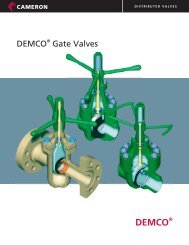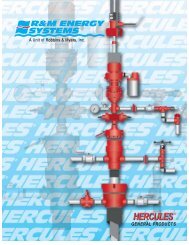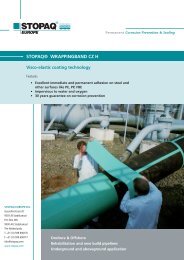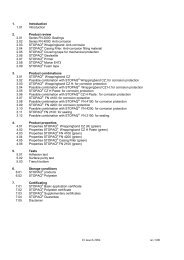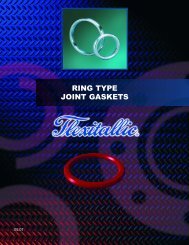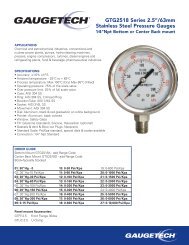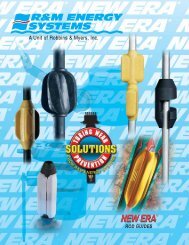Welcome to the Next Generation of Sealing ... - CE Franklin Ltd.
Welcome to the Next Generation of Sealing ... - CE Franklin Ltd.
Welcome to the Next Generation of Sealing ... - CE Franklin Ltd.
You also want an ePaper? Increase the reach of your titles
YUMPU automatically turns print PDFs into web optimized ePapers that Google loves.
Spiral Wound Gaskets<br />
A requirement <strong>of</strong> any gasket is <strong>the</strong> ability <strong>to</strong> recover under variable loads. The effects <strong>of</strong> pressure<br />
and temperature fluctuations, <strong>the</strong> temperature difference across <strong>the</strong> flange face, along<br />
with flange rotation, bolt stress relaxation and creep, demand a gasket with adequate flexibility<br />
and recovery, <strong>to</strong> maintain a seal under variable working conditions. The spiral wound gasket,<br />
invented by Flexitallic, meets <strong>the</strong>se requirements.<br />
Metal Strip<br />
Filler Material<br />
A spiral wound gasket is manufactured by spirally winding a preformed metal strip and a filler<br />
on <strong>the</strong> outer periphery <strong>of</strong> metal winding mandrels. The winding mandrel outside diameter<br />
forms <strong>the</strong> inner diameter <strong>of</strong> <strong>the</strong> gasket and <strong>the</strong> superposed metal and non-metallic windings<br />
are continually wound until <strong>the</strong> required outer diameter is attained. Normal practice is <strong>to</strong> reinforce<br />
<strong>the</strong> inner and outer diameters with several plies <strong>of</strong> metal without fillers. This engineered<br />
product is “tailor made” <strong>to</strong> be compatible with <strong>the</strong> flange closure in which it is <strong>to</strong> be used.<br />
For example, a closure designed for vacuum service may require a gasket <strong>of</strong> exactly <strong>the</strong> same<br />
dimensions as a closure designed for 1500 psi service. The closure designed for <strong>the</strong> vacuum<br />
service would have relatively light bolting indicating <strong>the</strong> necessity for a s<strong>of</strong>t gasket, while <strong>the</strong><br />
1500 psi application would have heavy bolting requiring a relatively dense gasket. It is usually<br />
within our capability <strong>to</strong> satisfy both requirements.<br />
CHART NO. 1<br />
GASKET COMPRESSION CHARACTERISTICS<br />
6” Style CG Gasket<br />
Contact Area: 14.7 Square Inches<br />
Original Gasket Thickness 0.175”<br />
This chart shows compression <strong>to</strong> 0.130” under stud stress <strong>of</strong> 30,000 psi <strong>of</strong> root area<br />
GASKET LOAD IN THOUSANDS OF POUNDS<br />
250<br />
200<br />
150<br />
100<br />
50<br />
262,000<br />
Class 900<br />
198,000<br />
Class 600<br />
150,000<br />
Class 400<br />
.180 .170 .160 .150 .140 .130<br />
GASKET THICKNESS IN INCHES<br />
GASKET DENSITY<br />
The service conditions under which a FLEXITALLIC spiral<br />
wound gasket is expected <strong>to</strong> hold its seal dictate <strong>the</strong> density<br />
<strong>of</strong> <strong>the</strong> gasket. Gaskets that have identical inside and outside<br />
diameters can be ei<strong>the</strong>r hard or s<strong>of</strong>t as shown on <strong>the</strong> left.<br />
The available compressive force is <strong>the</strong> basis for calculating<br />
<strong>the</strong> density <strong>of</strong> <strong>the</strong> gasket structure <strong>to</strong> support specific loads.<br />
22<br />
<strong>Welcome</strong> <strong>to</strong> <strong>the</strong> <strong>Next</strong> <strong>Generation</strong> <strong>of</strong> <strong>Sealing</strong> Technology<br />
®



